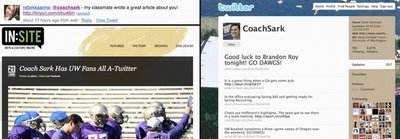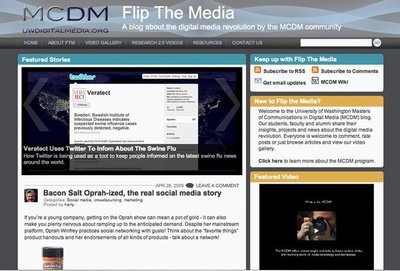April 30, 2009
Plugged in: UW is tweeting its way into a new social media ecosystem
Make way: Social media is bulldozing the time-worn landscape of traditional media, one 140-character “tweet” at a time.
What we’re left with is a new media ecosystem, in which the traditional kings of the news food-chain — major television and print news organizations — have been dethroned by the buzzing, chattering and, yes, twittering masses, who have found they can learn and share information more quickly and efficiently amongst themselves.
What does this new ecosystem mean for the future of news distribution? How does it affect the way we teach and learn communication skills? And the big question, of course, is: What will they think of next?
Navigating the new ecosystem
All the answers are still up in the air, said Hanson Hosein, director of the Master of Communication in Digital Media (MCDM) program at UW. Although he regularly uses the micro-blogging Web site Twitter (@hrhmedia), has a Facebook profile and blogs about the digital media revolution on FlipTheMedia.com, Hosein relies on his students to help him keep up with the ever-changing new ecosystem.
“I take a collaborative approach to using social media tools in my class because I can’t even pretend to be an expert on this stuff. It’s too much for one person to master,” he said. “I keep an eye on it, and I basically act more as a guide. We have such great students who come with a lot of experience and their own perspectives, and the idea is that the sum of our parts is better than we are individually.”
Hosein’s goal is not to teach students how to use ubiquitous tools like Twitter and Facebook, but how to optimize their use in the wake of traditional mass media’s collapse.
“The equation in communication is changing very quickly, and what we’re looking for in educating our students is an understanding of that, and figuring out what’s going to make a difference now,” Hosein said. “How can you get your message out in this new ecosystem?”
Part of his collaborative teaching method is allowing students to use social media during class — an idea many professors would never dream of, but that Hosein said can be very productive.
He explained that two simultaneous conversations — an in-class lecture and a Twitter discussion, via students’ laptops and cell phones — can create a more engaging learning environment. He’ll occasionally encourage students to tweet during class and mark their thoughts about the lecture with a hash tag — the pound symbol and a keyword, such as #uwmcdm for the program, or #mcdm581 for a specific class — so students can search the tag on Twitter and see a real-time stream of tweets from their classmates.
“Students who are either too shy to talk or don’t think something they’re thinking is relevant to the discussion will put something on Twitter,” Hosein said. “It works out that, in a way, it actually adds to the learning process, whether it’s during class or after class. People can go back and refer to the Twitter feed, so it’s part of the record of the class.”
While a live Twitter feed is not realistic for all classes, Hosein said the general advantage of using social media at the University is that it avoids the traditional, top-down approach to distributing information. In the new media ecosystem, he said, people don’t want to passively listen to an authoritative source. Instead, they thrive on active conversations and information-sharing relationships with everyone from friends to celebrities to major news organizations (@cnn, for example).
“Twitter is useful as a news tool for university entities, like the law school. It allows them to engage in a more authentic relationship with people who might be interested in the school,” Hosein said. “For example, sometimes I’ll see tweets from the law school saying something like, ‘I’m interviewing an interesting candidate for the dean’s position.’ That’s stuff you don’t normally put out to the public, but it shows more behind the scenes and it makes the institution less imposing and much more human.
“When you’re telling your personal story or your organization’s story, you’re building a personal brand through a combination of news, experiences, thoughts and day-to-day stuff.”
Hosein has taken his collaborative educational approach to the next level with the creation of MCDM’s Media Space, which is currently a beta version. A small group of MCDM students created what Hosein calls a “Facebook meets Wiki meets YouTube” platform in a recent independent study class. It’s intended to help break down the walls of traditional academia by providing a space for in-class and interdisciplinary collaboration, as well as for partnerships with outside businesses and civic organizations.
Advertising in a digital world
Mairead Reinhard, communications, marketing and alumni relations manager for the College of Education, also uses social media to spread news and make the college more accessible. She manages the college’s Facebook ads, which they started running in January, as well as its Twitter page (@uwcollegeofed).
“I think fundamentally, as communications and marketing people, we should all be asking how digital advertising works within the unit’s broader plan,” Reinhard said. “I think it’s just one tactic of many. We can’t discount print and radio campaigns or other tools, but we should be using social networking because it has such a large audience.”
And it includes the advantages of being able to target a specific demographic, allowing advertisers a better chance of reaching people who are interested in them than a traditional newspaper ad. “Facebook allows you to restrict your ad by age, target by region, by whether someone is a graduate, undergraduate or prospective student, and even specify certain interests,” she explained.
It also allows advertisers to start and stop ad campaigns in real time — an especially helpful tool on a limited University budget. “If I’m running an ad about our College of Education open house, I can run it on a schedule leading up to the event, but I can pause or stop the ad entirely if I see we’re getting low on budget,” Reinhard said.
“You can also set yourself a daily budget for ads so Facebook won’t go over that amount. If I’m getting massive response [in the form of clicks] one day, I can keep it going. Or I can pause the ad if I feel the market is getting too saturated, and then I can restart the ad when it’s fresh again.”
Ultimately, social networking can be used to advertisers’ advantage because it directly measures how people respond, and the feedback is invaluable for marketing strategists who want to get the best possible result for their money.
Luring readers back to news through social media
Department of Communication lecturer Florangela Davila not only asks her journalism students, “Did you post your story online yet?” but also, “Did you tweet about it? Did you leave links on message boards?”
20 journalism students have taken on the task of drawing 16 to 25-year-olds back into the habit of reading news — not an easy venture, since a recent study by the Pew Research Center for the People & the Press shows that 34 percent of young people get no news on a typical day.
The result of their efforts is In:Site, a Web site and Facebook application that’s a mix of original and aggregated news, multimedia and interactive content about arts and culture in Seattle and elsewhere. The project is a collaboration with Seattle-based NewsCloud, which aggregates and provides open-source software for social media, like Facebook applications.
“[NewsCloud founder] Jeff Reifman approached the department this past winter,” Davila explained. “His proposal — to collaborate with us — fit in perfectly with the department’s goals to offer more multimedia training as well as to start developing an entrepreneurial journalism class. We all see what’s happening with the newspaper business. But we believe the news business is just reinventing itself and that it’s important for us, as educators, to expose students to all sorts of careers possibilities.”
Davila and her students analyze new Web sites, like Seattle PostGlobe, which is run by former Seattle P-I staffers, to examine how journalists can launch their own start-ups in a post-print age. But their main goals are to become known as a credible news source, to build a community on Facebook, and to use social media to drive traffic to the site and build relationships with the target demographic.
One of the most interesting things about In:Site – besides how clean and professional it looks after only five weeks – is how social media is both a subject of its news and a strategy for getting young people to read the news.
For example, senior Maks Goldenshteyn wrote an article for In:Site about how new head football coach Steve Sarkisian uses Twitter to spread Husky news and connect with fans. His classmate, Rebecca Livingston, tweeted, “@coachsark – My classmate wrote a great article about you!” and provided a link. Her tweet appeared on a live Twitter feed of posts that mention @coachsark, so football fans who follow mentions of him on Twitter can navigate to In:Site and read about… well, his Twitter.
Several of the students have their own Twitter accounts, but you can keep up on the latest In:Site news at the official Twitter page: @seattleinsite.
What’s next?
If the wild intersections of Facebook, Twitter, applications, blogging and more have you confused, fear not – most everyone else is just as bewildered. “We’re all making it up as we go along; this stuff is moving so fast,” said Hosein. “If anybody says they’re a social media expert, they usually don’t know what’s really going on because it’s so hard to figure this stuff out.”
The best way to understand social media is to get involved yourself – create a Twitter account, log onto In:Site, keep an eye on Flip The Media and see where it all takes you.
“Social media changes the way we communicate and strikes at the heart of how we organize as a society,” said Hosein. “Thanks to the Internet, we can now self-organize, share, collaborate and take action in a way that once required the intervention of an institution – government, a company or large organization. That’s pretty revolutionary.”




